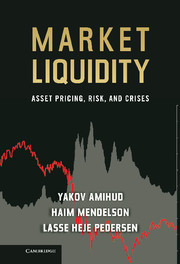Introduction and Overview of the Book
Published online by Cambridge University Press: 05 December 2012
Summary
This book is about the pricing of liquidity. We present theory and evidence on how liquidity affects securities prices, why liquidity varies over time, how a drop in liquidity leads to a decline in prices, and why liquidity crises create liquidity spirals. The analysis has important implications for traders, risk managers, central bankers, performance evaluation, economic policy, regulation of financial markets, management of liquidity crises, and academic research.
Liquidity and its converse, illiquidity, are elusive concepts: You know it when you see it, but it is hard to define. A liquid security is characterized by the ability to buy or sell large amounts of it at low cost. A good example is U.S. Treasury bills, which can be sold in blocks of $20 million dollars instantaneously at the cost of a fraction of a basis point. On the other hand, trading an illiquid security is difficult, time-consuming, and/or costly. Illiquidity is observed when there is a large difference between the offered sale price and the bid (buying) price, if trading of a large quantity of a security moves its price by a lot, or when it takes a long time to unload a position. A recent example of this is collateralized debt obligations, which investment banks have not been able to unload at an acceptable price for a long time.
- Type
- Chapter
- Information
- Market LiquidityAsset Pricing, Risk, and Crises, pp. ix - xivPublisher: Cambridge University PressPrint publication year: 2012



